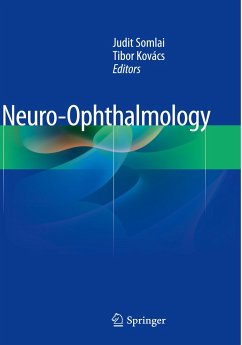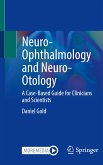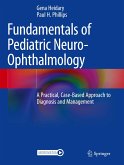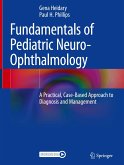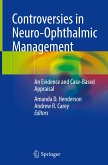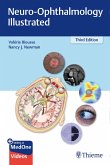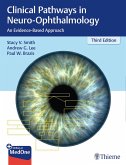Neuro-Ophthalmology
Herausgegeben:Somlai, Judit; Kovács, Tibor
Neuro-Ophthalmology
Herausgegeben:Somlai, Judit; Kovács, Tibor
- Broschiertes Buch
- Merkliste
- Auf die Merkliste
- Bewerten Bewerten
- Teilen
- Produkt teilen
- Produkterinnerung
- Produkterinnerung
This practical guide provides an algorithm for diagnosis and treatment, from 'having some problem with vision', via diagnosis of cause and background, to treatment and eventually to rehabilitation.
Following on from introductory sections devoted to the role of neuro-ophthalmology, recent developments in the field, and an overview of neuro-ophthalmological examinations, there are sections devoted to the different parts of the visual system, and finally a section on rehabilitation.
Neuro-ophthalmology is aimed at ophthalmologists, neurologists, neurosurgeons, traumatologists,…mehr
Andere Kunden interessierten sich auch für
![Neuro-Ophthalmology and Neuro-Otology Neuro-Ophthalmology and Neuro-Otology]() Daniel GoldNeuro-Ophthalmology and Neuro-Otology59,99 €
Daniel GoldNeuro-Ophthalmology and Neuro-Otology59,99 €![Fundamentals of Pediatric Neuro-Ophthalmology Fundamentals of Pediatric Neuro-Ophthalmology]() Fundamentals of Pediatric Neuro-Ophthalmology55,99 €
Fundamentals of Pediatric Neuro-Ophthalmology55,99 €![Controversies in Neuro-Ophthalmic Management Controversies in Neuro-Ophthalmic Management]() Controversies in Neuro-Ophthalmic Management85,99 €
Controversies in Neuro-Ophthalmic Management85,99 €![Fundamentals of Pediatric Neuro-Ophthalmology Fundamentals of Pediatric Neuro-Ophthalmology]() Fundamentals of Pediatric Neuro-Ophthalmology79,99 €
Fundamentals of Pediatric Neuro-Ophthalmology79,99 €![Controversies in Neuro-Ophthalmic Management Controversies in Neuro-Ophthalmic Management]() Controversies in Neuro-Ophthalmic Management118,99 €
Controversies in Neuro-Ophthalmic Management118,99 €![Neuro-Ophthalmology Illustrated Neuro-Ophthalmology Illustrated]() Valerie BiousseNeuro-Ophthalmology Illustrated130,99 €
Valerie BiousseNeuro-Ophthalmology Illustrated130,99 €![Clinical Pathways in Neuro-Ophthalmology Clinical Pathways in Neuro-Ophthalmology]() Stacy SmithClinical Pathways in Neuro-Ophthalmology106,99 €
Stacy SmithClinical Pathways in Neuro-Ophthalmology106,99 €-
-
-
This practical guide provides an algorithm for diagnosis and treatment, from 'having some problem with vision', via diagnosis of cause and background, to treatment and eventually to rehabilitation.
Following on from introductory sections devoted to the role of neuro-ophthalmology, recent developments in the field, and an overview of neuro-ophthalmological examinations, there are sections devoted to the different parts of the visual system, and finally a section on rehabilitation.
Neuro-ophthalmology is aimed at ophthalmologists, neurologists, neurosurgeons, traumatologists, neuroradiologists, experts in cardiology and stroke, and trainees in these areas. It will also be of interest to neuro-rehabilitation specialists, neuropsychologists, and those working in typhlopedagogy and health informatics.
Following on from introductory sections devoted to the role of neuro-ophthalmology, recent developments in the field, and an overview of neuro-ophthalmological examinations, there are sections devoted to the different parts of the visual system, and finally a section on rehabilitation.
Neuro-ophthalmology is aimed at ophthalmologists, neurologists, neurosurgeons, traumatologists, neuroradiologists, experts in cardiology and stroke, and trainees in these areas. It will also be of interest to neuro-rehabilitation specialists, neuropsychologists, and those working in typhlopedagogy and health informatics.
Produktdetails
- Produktdetails
- Verlag: Springer / Springer International Publishing / Springer, Berlin
- Artikelnr. des Verlages: 978-3-319-80463-7
- Softcover reprint of the original 1st ed. 2016
- Seitenzahl: 752
- Erscheinungstermin: 7. Juni 2018
- Englisch
- Abmessung: 254mm x 178mm x 38mm
- Gewicht: 1558g
- ISBN-13: 9783319804637
- ISBN-10: 3319804634
- Artikelnr.: 53573870
- Herstellerkennzeichnung Die Herstellerinformationen sind derzeit nicht verfügbar.
- Verlag: Springer / Springer International Publishing / Springer, Berlin
- Artikelnr. des Verlages: 978-3-319-80463-7
- Softcover reprint of the original 1st ed. 2016
- Seitenzahl: 752
- Erscheinungstermin: 7. Juni 2018
- Englisch
- Abmessung: 254mm x 178mm x 38mm
- Gewicht: 1558g
- ISBN-13: 9783319804637
- ISBN-10: 3319804634
- Artikelnr.: 53573870
- Herstellerkennzeichnung Die Herstellerinformationen sind derzeit nicht verfügbar.
Judit Somlai, neurologist, ophthalmologist, neuro-ophthalmologist Head of Unit, Unit of Neuro-Ophthalmology, Department of Neurology & Stroke Military Hospital, Budapest, Hungary Tibor Kovács, neurologist, neuro-pathologist, clinical pharmacologist Deputy Director, Associate Professor, Department of Neurology Semmelweis University, Budapest, Hungary
THE IMPORTANCE AND ROLE OF NEURO-OPHTHALMOLOGY.- The importance and role of neuro-ophthalmology in ophthalmological clinical practice.- The importance of neuro-ophthalmology in neurology.- OBJECTIVES AND RECENT RESULTS IN THE NEURO-OPHTHALMOLOGICAL CLINICAL PRACTICE.- Mechanisms of parallel information processing in the visual system.- A new direction: neuro-endocrino-immunology.- Visual and eye movement disorders in internal diseases.- Genetic aspects of neuro-ophthalmological diseases.- Recent knowledge in the neurosurgical practice regarding the visual system.- The role of gamma knife stereotactic radiosurgery in the treatment of neuro-ophthalmological diseases.- Neurointerventional treatment of diseases causing neuro-ophthalmological symptoms.- Recent results in neuropathology: demyelinating and conformational diseases.- CONVENTIONAL, NOVEL AND COMPLEMENTARY EXAMINATIONS IN OPHTHALMOLOGY.- Functional tests of the visual pathway system.- Algorithm of the neuro-ophthalmological examination used in the international practice.- Objective and subjective examination methods of visual acuity.- Examination of contrast sensitivity.- Examination of color vision.- Electroretinography (ERG): electrophysiological examination of the retina.- Functional examinations of the visual pathway system with electrophysiological methods.- Clinical importance of conventional and modern visual field tests in the topographical diagnostics of optic nerve disorders.- The differential diagnosis of visual field deficits at the bedside.- The role of fluorescein angiography and optical coherence tomography in the examination of circulatory disorders of the optic disc.- Optical coherence tomography of the optic disc and the macula in neurodegenerative diseases.- Neuro-ophthalmological examinations of the eye movements.- Diagnosis, differential diagnosis and treatment of congenital oculomotor disorders.- Polatest procedure.- Physiology and examination methods of the pupillomotor pathway.- Neuro-ophthalmological methods for the clinical analysis of double vision.- Supplementary test procedures.- Duplex ultrasound examination of the carotid and vertebral arteries.- Transcranial Doppler examination.- Color Doppler ultrasound examinations in orbital diseases.- The role of ophthalmological ultrasound in neuro-ophthalmology.- The role of EMG-ENG in diagnosing neuro-ophthalmologic diseases.- Computed tomography examinations.- Neuroradiology, functional MRI.- Novel information regarding the visual and eye movement systems in Otoneurology.- Electro-oculography (EOG) examination of eye movements.- The importance of familial thrombophilias in the clinical practice.- Modern possibility in anticoagulant therapy.- Novel consideration regarding the role of evoked potential in confirming.- The diagnosis of eye movement disorders of brainstem origin.- DISEASES OF RETINA AND THE OPTIC NERVE (VISUAL AND SENSORY SYSTEM).- Congenital diseases of the retina and the visual pathway.- Hereditarydiseases of the retina.- The roles of electroretinography (ERG) and visual evoked potential (VEP) examinations in the diseases of the retina and/or the optic nerve.- Congenital diseases of the optic nerve.- Phacomatoses.- Acquired diseases of the optic nerve.- Inflammatory diseases of the optic nerve.- Retrobulbar optic neuropathy - from the neurologist's approach.- Neuroyelitis optica (Devic's disease): A new concept for an old disease.- Acquired inflammatory diseases of the optic nerve - the neuro-ophthalmologist's approach.- Circulatory disorders of the optic nerve.- Vascular diseases of the optic nerve - internal medicine aspect.- The cardiovascular background of 'intracerebral small vessel disease'.- Vascular diseases of the optic nerve - the neuro-ophthalmologist's approach.- Compressive optic neuropathy.- Diseases causing compression of the optic nerve - the neurosurgeon's perspective.- Bernadett Salomváry: Neuro-ophthalmological aspects of tumors causing compression of the visual pathway system.- Traumatic optic neuropathy.- The significance of Neuro-Ophthalmology in the diagnosis and therapy of cranial trauma.- Toxic and deficiency optic neuropathy.- Optic pathway diseases of nutritional and toxic origin.- Eye-related symptoms and signs of intracranial hypertension.- Eye-related symptoms and signs of intracranial hypertension.- Blind spot enlargement syndrome.- NEURO-OPHTHALMOLOGIC ASPECTS OF THE OCULAR MOTOR SYSTEM.- Disorders of the pupillomotor pathway.- The most important disorders of the pupillomotor pathway in the clinical practice.- Infranuclear and nuclear neurogenic paresis.- Congenital eye movement disorders.- The most important clinical syndromes of acquired nuclear and infranuclear eye movement disorders and their diagnostic and therapeutic options.- Neurogenic pareses due to dysfunction of the brainstem.- Eye movement disorders related to brainstem dysfunctions - types, clinical significance of vertical localization, modern therapeutic principles.- The clinical significance of otoneurology in the diagnosis brainstem disorders.- Examination of the eye movements of the patient in coma.- Supranuclear eye movement systems and their clinical significance.- Supranuclear regulation of the eye movements and the significance of their disturbances.- Disorders of neuromuscular junction (MG and OMG), non-isolated ocular muscle paresis and myogenic paresis.- Disorders of the neuromuscular junction and their diagnostics.- The ocular characteristics and differential diagnostics of mixed types eye movement disorders (disorders of ocular neuromuscular junction (OMG), non-isolated ocular muscle paresis and myogenic paresis).- Ocular myasthenia gravis.- Non-isolated ocular muscle palsies.- Myogenic pareses.- Endocrine myopathy and orbitopathy.- DISEASES OF THE ORBIT.- Diagnostics and therapy of the diseases of the orbit.- Traumatic injuries of the orbit.- NEURO-OPHTHALMOLOGICAL CONSIDERATIONS OF THE FACIAL NERVE.- Tumor lesions of the facialnerve.- THE NEURO-OPHTHALMOLOGICAL ASPECTS OF HEADACHES.- Neuro-Ophthalmological aspects of headaches - from the neurologist's approach.- REHABILITATION.- Viewing down from the top-Visual impairments developing as a consequence of cortical injury.- Ignored world without missing it - Neglect.- Introducing tools and services helping life of people with impaired vision.- Elementary and occupational rehabilitation of people with impaired vision.- The importance and options of rehablitation on behalf of a neuro-ophthalmologist.
THE IMPORTANCE AND ROLE OF NEURO-OPHTHALMOLOGY.- The importance and role of neuro-ophthalmology in ophthalmological clinical practice.- The importance of neuro-ophthalmology in neurology.- OBJECTIVES AND RECENT RESULTS IN THE NEURO-OPHTHALMOLOGICAL CLINICAL PRACTICE.- Mechanisms of parallel information processing in the visual system.- A new direction: neuro-endocrino-immunology.- Visual and eye movement disorders in internal diseases.- Genetic aspects of neuro-ophthalmological diseases.- Recent knowledge in the neurosurgical practice regarding the visual system.- The role of gamma knife stereotactic radiosurgery in the treatment of neuro-ophthalmological diseases.- Neurointerventional treatment of diseases causing neuro-ophthalmological symptoms.- Recent results in neuropathology: demyelinating and conformational diseases.- CONVENTIONAL, NOVEL AND COMPLEMENTARY EXAMINATIONS IN OPHTHALMOLOGY.- Functional tests of the visual pathway system.- Algorithm of the neuro-ophthalmological examination used in the international practice.- Objective and subjective examination methods of visual acuity.- Examination of contrast sensitivity.- Examination of color vision.- Electroretinography (ERG): electrophysiological examination of the retina.- Functional examinations of the visual pathway system with electrophysiological methods.- Clinical importance of conventional and modern visual field tests in the topographical diagnostics of optic nerve disorders.- The differential diagnosis of visual field deficits at the bedside.- The role of fluorescein angiography and optical coherence tomography in the examination of circulatory disorders of the optic disc.- Optical coherence tomography of the optic disc and the macula in neurodegenerative diseases.- Neuro-ophthalmological examinations of the eye movements.- Diagnosis, differential diagnosis and treatment of congenital oculomotor disorders.- Polatest procedure.- Physiology and examination methods of the pupillomotor pathway.- Neuro-ophthalmological methods for the clinical analysis of double vision.- Supplementary test procedures.- Duplex ultrasound examination of the carotid and vertebral arteries.- Transcranial Doppler examination.- Color Doppler ultrasound examinations in orbital diseases.- The role of ophthalmological ultrasound in neuro-ophthalmology.- The role of EMG-ENG in diagnosing neuro-ophthalmologic diseases.- Computed tomography examinations.- Neuroradiology, functional MRI.- Novel information regarding the visual and eye movement systems in Otoneurology.- Electro-oculography (EOG) examination of eye movements.- The importance of familial thrombophilias in the clinical practice.- Modern possibility in anticoagulant therapy.- Novel consideration regarding the role of evoked potential in confirming.- The diagnosis of eye movement disorders of brainstem origin.- DISEASES OF RETINA AND THE OPTIC NERVE (VISUAL AND SENSORY SYSTEM).- Congenital diseases of the retina and the visual pathway.- Hereditarydiseases of the retina.- The roles of electroretinography (ERG) and visual evoked potential (VEP) examinations in the diseases of the retina and/or the optic nerve.- Congenital diseases of the optic nerve.- Phacomatoses.- Acquired diseases of the optic nerve.- Inflammatory diseases of the optic nerve.- Retrobulbar optic neuropathy - from the neurologist's approach.- Neuroyelitis optica (Devic's disease): A new concept for an old disease.- Acquired inflammatory diseases of the optic nerve - the neuro-ophthalmologist's approach.- Circulatory disorders of the optic nerve.- Vascular diseases of the optic nerve - internal medicine aspect.- The cardiovascular background of 'intracerebral small vessel disease'.- Vascular diseases of the optic nerve - the neuro-ophthalmologist's approach.- Compressive optic neuropathy.- Diseases causing compression of the optic nerve - the neurosurgeon's perspective.- Bernadett Salomváry: Neuro-ophthalmological aspects of tumors causing compression of the visual pathway system.- Traumatic optic neuropathy.- The significance of Neuro-Ophthalmology in the diagnosis and therapy of cranial trauma.- Toxic and deficiency optic neuropathy.- Optic pathway diseases of nutritional and toxic origin.- Eye-related symptoms and signs of intracranial hypertension.- Eye-related symptoms and signs of intracranial hypertension.- Blind spot enlargement syndrome.- NEURO-OPHTHALMOLOGIC ASPECTS OF THE OCULAR MOTOR SYSTEM.- Disorders of the pupillomotor pathway.- The most important disorders of the pupillomotor pathway in the clinical practice.- Infranuclear and nuclear neurogenic paresis.- Congenital eye movement disorders.- The most important clinical syndromes of acquired nuclear and infranuclear eye movement disorders and their diagnostic and therapeutic options.- Neurogenic pareses due to dysfunction of the brainstem.- Eye movement disorders related to brainstem dysfunctions - types, clinical significance of vertical localization, modern therapeutic principles.- The clinical significance of otoneurology in the diagnosis brainstem disorders.- Examination of the eye movements of the patient in coma.- Supranuclear eye movement systems and their clinical significance.- Supranuclear regulation of the eye movements and the significance of their disturbances.- Disorders of neuromuscular junction (MG and OMG), non-isolated ocular muscle paresis and myogenic paresis.- Disorders of the neuromuscular junction and their diagnostics.- The ocular characteristics and differential diagnostics of mixed types eye movement disorders (disorders of ocular neuromuscular junction (OMG), non-isolated ocular muscle paresis and myogenic paresis).- Ocular myasthenia gravis.- Non-isolated ocular muscle palsies.- Myogenic pareses.- Endocrine myopathy and orbitopathy.- DISEASES OF THE ORBIT.- Diagnostics and therapy of the diseases of the orbit.- Traumatic injuries of the orbit.- NEURO-OPHTHALMOLOGICAL CONSIDERATIONS OF THE FACIAL NERVE.- Tumor lesions of the facialnerve.- THE NEURO-OPHTHALMOLOGICAL ASPECTS OF HEADACHES.- Neuro-Ophthalmological aspects of headaches - from the neurologist's approach.- REHABILITATION.- Viewing down from the top-Visual impairments developing as a consequence of cortical injury.- Ignored world without missing it - Neglect.- Introducing tools and services helping life of people with impaired vision.- Elementary and occupational rehabilitation of people with impaired vision.- The importance and options of rehablitation on behalf of a neuro-ophthalmologist.
"The book really is a tour de force. The illustrations, of which there is an ample number, are generally of excellent quality, including MRIs, CTs, fundus photographs, and visual field reproductions. In summary, there currently are a host of fine textbooks available for the reader who wishes to learn about the diagnosis and management of known or presumed neuroophthalmological disorders, but there is none any better than this one. Get it, read it, and learn from it!" (Neil R. Miller, Journal of Neuro-Ophthalmology, October, 2016)

